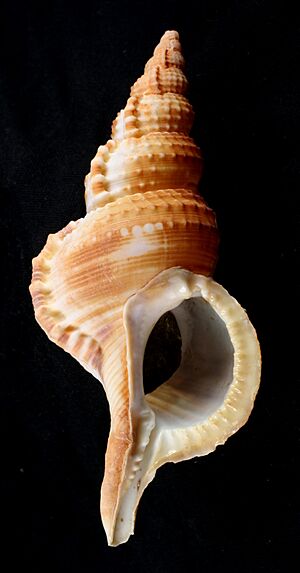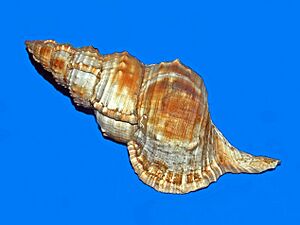Ranella olearium facts for kids
Quick facts for kids Ranella olearium |
|
|---|---|
 |
|
| A close-up view of the Ranella olearium shell | |
| Conservation status | |
| Scientific classification | |
| Synonyms | |
|
See text |
Ranella olearium, often called the wandering triton or little frog triton, is a very large sea snail. It's a type of marine gastropod mollusc, which means it's a snail that lives in the ocean. These fascinating creatures belong to the family Ranellidae, known as the triton snails.
Where Does the Wandering Triton Live?
This amazing sea snail can be found in many different parts of the world. It lives in the waters around Europe and in the Mediterranean Sea. You can also find it in the central and southern parts of the Atlantic Ocean, near places like Cape Verde and West Africa.
It also makes its home in the Indian Ocean, off the coasts of Mozambique and South Africa. You might even spot it near New Zealand, in the Caribbean Sea (especially near Colombia), and in the southwestern Pacific Ocean.

What Does the Wandering Triton Look Like?
The shell of the Ranella olearium can be quite large, usually between 90 millimeters (about 3.5 inches) and 240 millimeters (about 9.5 inches) long! These shells are usually long, thick, and very strong.
They have rounded parts called whorls, and sometimes they have bumps or "tubercles" on their surface. The opening of the shell is big and round. It also has a special tube called a siphonal channel, which is moderately long. The edge of the shell's opening has many teeth, which are often in pairs. This edge is usually smooth and can be white or brown.
The outside of the shell is typically a brownish-yellow color, with lighter bumps and raised areas. The inside of the shell and the central column (called the columella) are white. When the snail is alive, its shell is often covered with a soft, velvety outer layer.
Where Does the Wandering Triton Live?
These large sea snails prefer to live on the ocean floor, where it's sandy or muddy. They are found in deeper waters, usually starting at a depth of about 100 meters (about 330 feet). They can live as deep as 280 meters (about 920 feet) below the surface.


